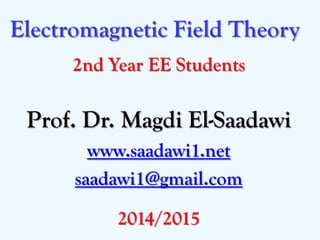Lec 02 2015 electromagnetic
- 1. Electromagnetic Field Theory 2nd Year EE Students Prof. Dr. Magdi El-Saadawi www.saadawi1.net saadawi1@gmail.com 2014/2015
- 2. Chapter 1 VECTOR ALGEBRA (Continue) 10/16/2014 Prof. Dr. Magdi El-Saadawi 2
- 3. 1.5. Vector Multiplication ’āśVectors may be multiplied by scalars: The magnitude of the vector changes, but its direction does not when the scalar is positive. ’āśIn case of vector multiplication: ’é¦the dot product (also called scalar product) ’é¦the cross product (also called vector product). 10/16/2014 Prof. Dr. Magdi El-Saadawi 3
- 4. 1.5.1 The dot Product ’āśTwo vectors and are said to be orthogonal (or perpendicular) with each other if 10/16/2014 Prof. Dr. Magdi El-Saadawi 4
- 5. 1.5.1 The dot Product ’āśThe dot product obeys the following identities: 10/16/2014Prof. Dr. Magdi El-Saadawi5
- 6. 1.5.1 The dot Product The most common applicationof the dot product is: The mechanical work W, where a constant force F applied over a straight displacement L does an amount of work i.e. Another example is the magnetic fields ╬”, where 10/16/2014 Prof. Dr. Magdi El-Saadawi 6
- 7. 1.5.2 The cross product10/16/2014 Prof. Dr. Magdi El-Saadawi 7
- 8. 1.5.2 The cross product10/16/2014Prof. Dr. Magdi El-Saadawi8
- 9. 1.5.2 The cross product 10/16/2014 Prof. Dr. Magdi El-Saadawi9
- 10. 1.5.2 The cross product10/16/2014 Prof. Dr. Magdi El-Saadawi 10
- 11. 1.5.2 The cross product10/16/2014 Prof. Dr. Magdi El-Saadawi 11
- 12. 1.5.2 The cross product10/16/2014 Prof. Dr. Magdi El-Saadawi 12
- 13. 1.6. The Gradient The gradient of a scalar field is: a vector field that lies in the direction for which the scalar field is changing most rapidly. The magnitude of the gradient is the greatest rate of change of the scalar field.(see figure 1.9 pp. 19) 10/16/2014Prof. Dr. Magdi El-Saadawi13
- 14. 10/16/2014 Prof. Dr. Magdi El-Saadawi 14
- 15. 1.6. The Gradient10/16/2014 Prof. Dr. Magdi El-Saadawi 15
- 16. 1.6. The Gradient10/16/2014Prof. Dr. Magdi El-Saadawi16
- 17. 1.6. The Gradient10/16/2014Prof. Dr. Magdi El-Saadawi17
- 18. 10/16/2014Prof. Dr. Magdi El-Saadawi 18
- 19. 1.7. Divergence of a vector and Divergence Theorem The flux Assume a vector field A, continuous in a region containing the smooth surface S, we define the surface integral of the flux of through S as: Or For a closed surface 10/16/2014 Prof. Dr. Magdi El-Saadawi19
- 20. 10/16/2014Prof. Dr. Magdi El-Saadawi20
- 21. 1.7. Divergence of a vector and Divergence Theorem10/16/2014Prof. Dr. Magdi El-Saadawi21
- 22. ’āśIf there are no sources within the boundary surface, thus the integral will get the value zero (Fig. b) ’āśIf there is a source (or sink) within the surface of integration, which generates new field lines the integral will get a value different from zero (Fig. a). 10/16/2014 Prof. Dr. Magdi El-Saadawi 22
- 23. 10/16/2014Prof. Dr. Magdi El-Saadawi23
- 24. 1.7. Divergence of a vector and Divergence Theorem The theorem of Gauss(Divergence theorem) is proved from the definition of the divergence and it enables to transform surface integrals into volume integralsas follows: The volume integral about a specific flux from an element of volume V is equal to the flux thorough going from the closed surface S bounding this volume (V).10/16/2014Prof. Dr. Magdi El-Saadawi24
- 25. Examples 10/16/2014 Prof. Dr. Magdi El-Saadawi 25
- 26. 10/16/2014Prof. Dr. Magdi El-Saadawi26
- 27. Examples 10/16/2014 Prof. Dr. Magdi El-Saadawi27
- 28. Examples10/16/2014Prof. Dr. Magdi El-Saadawi 28
- 29. Examples 10/16/2014 Prof. Dr. Magdi El-Saadawi29





























